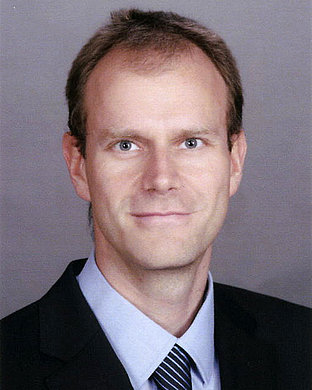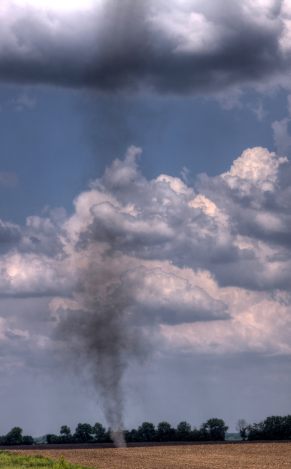It was just another sunny day for Harald Schulte. The evening was hot and humid, but that wasn’t unusual during the warm summer of 2001. Many people in the village of Belm in Northwestern Germany were actually hoping for some evening rain as a welcome way to cool down. But then disaster struck. “There was a sudden bang and I was pushed against the wall,” Schulte later recalled his experience of the tornado. “After 90 seconds it was all over, but everything was destroyed,” he told the local press.
Twisters in Europe
The US is affected by 1000s of tornadoes each year. In spring and early summer, tornadoes are a common occurrence across the Mid-West and southern United States, a total of sixteen tornadoes where reported across the US on the same day as in Moore, Oklahoma.
Statistically, Schulte was right to be surprised about the strength of the storm – though not about its occurrence. Meteorologists define tornados as columns of air that rotate at very high speeds (usually counter-clockwise in the Northern Hemisphere). Such storms are notorious in the United States. But they also occur in South America, South-Central and Eastern Asia, Africa and Australia, as well as Western and Central Europe, including the United Kingdom, the Netherlands and Germany.
Faster, higher, longer
Though rotating air columns have been observed in all these places they vary greatly in terms of duration (from less than a minute to 3.5 hours), path length (from a few meters to 352 km), forward speed (from almost static to 117 km/h) and most importantly, in terms of force.
According to Markus Stowasser, meteorologist at Allianz Re, measuring the force of
tornados is difficult, and this makes their classification controversial. The best known measure for quantifying their strength is the Fujita Scale. It ranges from 0, when a tornado causes only slight damage to trees or tents, to 5, when it can devastate large concrete buildings.
The tornado that hit Belm on August 6th 2001 was between force one and two. “In the whole of Germany there are usually only a couple of such storms per year,” says Stowasser, “and only few of them happen to
occur exactly over a town and wreak such havoc.” However, if one combines all tornados, including those of force 0 and 1, the yearly tornado count in Germany reaches an average of 45 a year.
That number has been rising over recent decades, and there are some suggestions that this might be related to global warming. “However, there is another reason why reports are increasing,” notes Stowasser. “With the spread of smart phones and the Internet, people tend to capture footage of tornados more often and then report their sightings over social media or the specifically introduced European Severe Weather Database.”
The storm of the century
Yet even in Germany there have been tornados of the highest magnitude. Bernold Feuerstein, a physicist at the Max Planck Institute for Nuclear Physics in Heidelberg and a member of the non-profit organisation European Severe Storms Laboratory, points to one particularly welldocumented case in 1764.
At the time, a pastor who worked as scientist interviewed numerous eyewitnesses and recorded the storm by drawing various maps, showing how it hit close to the village of Feldberg in the German region of Mecklenburg. His description of damaged buildings and uprooted trees suggest that the tornado must have reached force 5 – just like another storm in 1800, that devastated the village of Hainichen in Saxony.
Those events are still rare in comparison with the US, where the yearly tornado tally is usually around 1200. About 90% of those occur in the central plains between the Rocky Mountains and the Appalachian Mountains, an area about three times the size of Germany, often referred to as “tornado alley.”
No other region in the world has a geography so conducive to creating the perfect storm. First, warm and moist air from the Gulf of Mexico can travel far North, unimpeded by any mountains, to meet cold and dry air from Canada and the Rockies in the West. Due to the dramatic difference in temperature, the warm and moist air rises particularly fast through the cold air. The warm air then condenses, releases heat and accelerates its own upward drift all the way through the troposphere (about 10 km).

For a tornado to develop out of those instable air layers, a second condition is required: windshear. This describes the change in wind speed and direction across different heights in the atmosphere. That shearing effect rotates the air that rises and can turn it into a tornado. In contrast, Europe has no such tornado speedway. As Bernold Feuerstein explains, there are two major differences to the United States. Firstly, the Alps form a barrier from east to west that slows the air on its way across the continent and functions as a tornado shield. However, there is one area that is more exposed: the North European Plains stretching from the North and Baltic Sea to the German Uplands (the so called Mittelgebirge), where the village of Belm lies.
There air can travel more freely. But here the second difference to the US comes into play: Tornados would require windshear – and that is also less likely in Europe because the air currents in the atmosphere, known as “jet streams,” run differently from those in the US. “Interestingly, if tornados do occur in Western and Central Europe, they seem to develop more frequently over hilly terrain,” Feuerstein notes. One explanation is that changes in the roughness of the surface enhance local low-level windshear. That can help create a small tornado. But usually, it is not sufficiently strong to keep the spiralling storm going, which then often collapses after less than a minute.
Few but fearsome
The differences in physical geography make tornados in Europe rarer than in the US. However that is counteracted by human geography: More people live in the North German Plains (Norddeutsche Tiefland) than in America’s tornado alley, so even weaker storms sometimes create more destruction.
The extent of this is revealed in a recent study by the reinsurance company Munich Re. Over the last 20 years, there have been nine tornados in Germany that have caused damageequalling at least €10 million ($13.25 million); one of those hit the Saxon village of Grossenhain in 2010, causing damage of €108 million ($143 million) and killed a six-year old girl. That was also the biggest fear that Schulte had in the village of Belm a few years before. “The first thing I did as soon as I could get up after the storm was to check on my grandchild,” he recalls. He found the toddler still in bed; the child had only briefly woken up and had already gone back to sleep. “That’s when I realised that we had actually been lucky.”

Forward Looking Statement disclaimer
As with all content published on this site, these statements are subject to our Forward Looking Statement disclaimer: